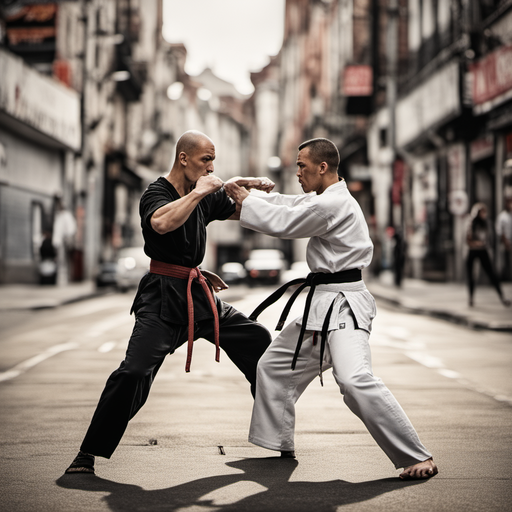Effective Martial Arts for Street Self-Defense
As an experienced martial arts instructor, I understand the importance of self-defense skills in today’s world. When it comes to protecting ourselves in real-life situations, choosing which martial arts to learn is crucial.
In this article, we will explore some of the most effective martial arts for street self-defense, focusing on techniques that can help you stay safe and confident in any unexpected encounter.
Krav Maga – The Art of Practical Self-Defense
Krav Maga is a highly effective and practical fighting style that originated in Israel. Developed for the Israeli Defense Forces, Krav Maga is designed to neutralize threats quickly and efficiently in real-life scenarios.
Simplicity and Effectiveness
Krav Maga focuses on simple and instinctive movements, making it easy to learn and apply. The techniques in Krav Maga are designed to be effective regardless of an individual’s size or strength.
Defense Against Common Attacks
Krav Maga equips practitioners to defend against common street attacks such as punches, kicks, chokes, and grabs. It emphasizes quick and decisive responses to create opportunities for escape.
Martial Arts Training for Real-Life Situations
In Krav Maga, training scenarios often simulate real-life encounters, allowing practitioners to develop situational awareness and the ability to respond under stress.
Brazilian Jiu-Jitsu – The Art of Ground Defense
Brazilian Jiu-Jitsu (BJJ) is a ground-based martial art that focuses on grappling and submission techniques. It is particularly effective for self-defense situations that end up on the ground.
Ground Defense and Submission Techniques
BJJ teaches practitioners to defend themselves effectively when the fight goes to the ground. Techniques such as joint locks, chokes, and positional control can neutralize opponents.
Escaping Holds and Grabs
While BJJ is known for its ground fighting techniques, it also incorporates methods to escape holds and grabs, enabling practitioners to regain their feet and continue defending themselves.
Limitations and Multiple Attackers
It is true that BJJ’s primary focus is on one-on-one ground combat, which may not be ideal in scenarios involving multiple attackers. In such situations, disengaging and fleeing may be a more practical option.
Muay Thai – The Art of Striking and Clinching
Muay Thai, also known as the “Art of Eight Limbs,” is a powerful striking style that includes the use of fists, elbows, knees, and shins. It also incorporates clinching techniques for close-range combat.
Devastating Striking Techniques
Muay Thai practitioners are trained in devastating striking techniques that can quickly incapacitate an attacker.
Clinching and Knee Strikes
The clinch is a dominant position in Muay Thai, allowing fighters to deliver powerful knee strikes to their opponents.
Creating Distance and Escaping Threats
Muay Thai teaches effective techniques to create distance from attackers and escape dangerous situations.
Wing Chun – The Art of Close-Range Combat
Wing Chun is a traditional Chinese martial art that focuses on close-range combat and practical self-defense techniques.
Centerline Theory and Quick Strikes
Wing Chun’s centerline theory allows practitioners to deliver quick and precise strikes to the most vulnerable areas of an attacker’s body.
Utilizing the Opponent’s Energy
Wing Chun emphasizes redirecting an opponent’s energy and using it against them, making it effective for self-defense regardless of the attacker’s size or strength.
Defending Against Grabs and Holds
Wing Chun techniques include effective defenses against grabs and holds, enabling practitioners to break free from an attacker’s grip.
Boxing – The Art of Punching Techniques
Boxing is a straightforward and effective fighting style that focuses on punching techniques and footwork.
Powerful Punching Techniques
Boxing hones the punching skills of its practitioners, making their strikes powerful and accurate.
Footwork and Evasion
Boxers are trained in footwork and evasion techniques to avoid incoming strikes and create angles for counterattacks.
Effective Defense and Counterpunching
Boxing emphasizes effective defense and counterpunching, enabling practitioners to respond quickly to an attacker’s movements.
Conclusion:
Choosing the right fighting style for street self-defense is essential for your safety and confidence. Krav Maga, Brazilian Jiu-Jitsu, Muay Thai, Wing Chun, and Boxing are among the most effective martial arts for real-life situations. Each style has its strengths and limitations, and it’s essential to consider your personal preferences, physical abilities, and the specific self-defense scenarios you may encounter.
Remember that mastering self-defense techniques requires consistent training and dedication. By learning effective martial arts and practicing regularly, you can develop the skills and confidence needed to protect yourself and others in potentially dangerous situations. Stay safe and empowered on your journey to exploring the world of self-defense and martial arts.

